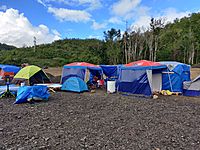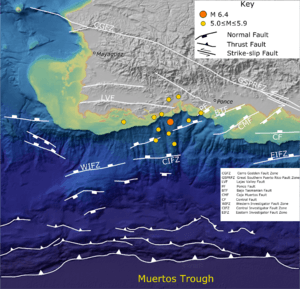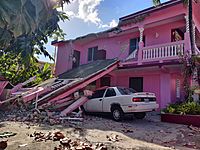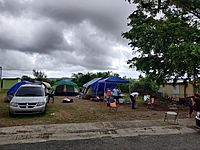2019–20 Puerto Rico earthquakes facts for kids
| UTC time | 2020-01-07 08:24:26 |
|---|---|
| ISC event | 617125982 |
| USGS-ANSS | ComCat |
| Local date | January 7, 2020 |
| Local time | 04:24 AST |
| Magnitude | 6.4 Mw |
| Depth | 10 km (6 mi) |
| Epicenter | 17°54′58″N 66°48′47″W / 17.916°N 66.813°W |
| Fault | Punta Montalva |
| Type | Oblique-slip normal |
| Total damage | $3.1 billion USD |
| Max. intensity | VIII (Severe) |
| Aftershocks | 7,600~ (M≥2.5, as of January 7 2022) |
| Casualties | 4 dead, 9 injured |
From late 2019 into 2022, the southwestern part of Puerto Rico was hit by many earthquakes. This series of quakes is called an earthquake swarm. There were 11 earthquakes that measured magnitude 5 or higher.
The strongest and most damaging quake happened on January 7, 2020. It had a magnitude of 6.4. This earthquake struck at 4:24 AM AST. People felt it very strongly, with an intensity of VIII (Severe) on the Modified Mercalli intensity scale. One person died, and several others were hurt.
A magnitude 5.8 earthquake the day before destroyed a natural arch. This arch was a famous tourist spot called Punta Ventana in Guayanilla. On January 11, a magnitude 5.9 aftershock hit. It damaged many buildings, including old historical sites and modern tall buildings in Ponce.
After the main quake, the entire island lost electricity. Power was slowly brought back over a week. Many homes were badly damaged. By January 14, over 8,000 people had lost their homes. They had to camp outdoors in shelters. In Ponce alone, 40,000 more people camped outside their homes. The government set up 28 refugee centers in 14 towns across southern and central Puerto Rico.
The damage to government buildings cost hundreds of millions of dollars. The total financial loss was about $3.1 billion. A power plant that supplied a quarter of Puerto Rico's energy was severely damaged. It was shut down, and repairs were expected to take at least a year.
On January 7, the day of the main quake, Puerto Rico's governor, Wanda Vázquez Garced, declared a state of emergency. She called on the Puerto Rico National Guard and the Puerto Rico State Guard for help. She also made $130 million available to the affected towns. The White House approved $5 million in federal emergency aid. After the January 11 aftershock, the governor gave $12 million to the six towns most affected. Tent cities were set up in five of the hardest-hit towns. These camps could hold about 3,200 people.
Contents
How Earthquakes Happen in Puerto Rico
Puerto Rico is located where two large pieces of the Earth's crust, called tectonic plates, meet. These are the Caribbean Plate and the North American Plate. These plates are always moving, but they move slowly. Sometimes, a smaller plate, called the Puerto Rico–Virgin Islands microplate, is also involved.
To the north of Puerto Rico, the North American Plate is sliding under this microplate. This happens along the Puerto Rico Trench. To the south, the microplate is pushing over the Caribbean Plate. This movement causes faults, which are cracks in the Earth's crust. When these faults move, they cause earthquakes.
The Series of Earthquakes
The earthquake activity started on December 28, 2019, with a magnitude 4.7 quake. A magnitude 5.0 earthquake followed early on December 29. Several smaller quakes happened over the next few days.
On January 6, a magnitude 5.8 earthquake occurred. The biggest quake, a magnitude 6.4, hit the next morning. Within 10 minutes, a magnitude 5.6 quake followed. About 15 minutes later, a magnitude 5.0 quake also occurred. The magnitude 6.4 quake was caused by a normal fault moving.
Another strong quake, a magnitude 5.9, happened on January 11. In the first month of this earthquake series, there were 11 quakes of magnitude 5 or higher. There were also 82 quakes between magnitude 4 and 4.9. On May 2, a magnitude 5.4 earthquake struck the same area. This quake also caused more shaking. By May 2, the total number of quakes over magnitude 3 was more than 1,000. There were 95 quakes over magnitude 4.
What Happened After the Quakes
People Affected by the Quakes
One man in Ponce died directly from the January 7 earthquake. Eight other people were injured in Ponce. A woman in Guayanilla had a heart attack and died after a magnitude 4.36 aftershock. This happened overnight between January 9 and 10. By January 10, two more people had died from health issues linked to the earthquakes.
People Without Homes
Many people lost their homes. The government set up 28 refugee centers. These centers were in towns across southern and central Puerto Rico. These towns included Yauco, Guánica, Ponce, Peñuelas, Guayanilla, Utuado, Maricao, Juana Díaz, Adjuntas, Sabana Grande, San Germán, Lajas, Jayuya, and Mayagüez.
The quakes also caused 28 families in Lares to lose their homes. At least three tall apartment buildings in Ponce became unsafe. This left many residents without a place to live.
By January 13, about 3,000 homes were destroyed or badly damaged. By January 14, the number of people without homes in the region reached 8,000. A list from January 15, 2020, showed at least 789 homes were completely unlivable. However, many more homes had some level of damage. For example, in Yauco alone, 3,200 homes had some damage.
Many experts noted the emotional impact on people. Entire families were left without homes, which was very difficult for them.
Damage to Buildings and Places

The January 7 earthquake destroyed many buildings. This included the Agripina Seda elementary school in Guánica. The Inmaculada Concepción Church in Guayanilla was also severely damaged. The La Guancha Recreational and Cultural Complex was also badly hit. It became unusable, and 24 businesses there had to close. The Auditorio Juan Pachín Vicéns and the Moscoso Building of the Ponce City Hall were also damaged.
The aftershock on January 11 caused even more damage. Buildings like the Ponce Servicios government building, Museo de la Masacre de Ponce, Residencia Armstrong-Poventud, and Casa Vives were affected.
In Ponce, both old historic buildings and new modern ones were damaged. These included Catedral de Nuestra Señora de Guadalupe, Museo de la Masacre, and the Iglesia Evangélica. Stores, hotels, and other buildings also suffered damage. The damage forced several streets in downtown Ponce to close. Guanica and Yauco were especially hard hit. The Guanica lighthouse was one of the buildings with significant damage in that town.
By January 11, Ponce alone had an estimated $150 million in damages. By January 14, the vice-mayor of Ponce estimated the damage in her town at $1 billion. The total financial losses for the region were about $3.1 billion.
The magnitude 5.5 earthquake on May 2 caused even more damage to buildings in Ponce. Some power outages were also reported.
Damage to Public Services
On January 7, the day of the 4:24 AM earthquake, there was no electricity in Ponce and most of Puerto Rico. More than 250,000 people island-wide lost water. Another half a million had no power. There were also rockslides and landslides.
The magnitude 5.9 aftershock on January 11 created a crack in a bridge. This was expected to delay getting power back. The Costa Sur power plant, which provides a quarter of the island's power, was severely damaged. Experts said it would take at least a year to fix. They even considered building a brand new plant instead of repairing the old one.
Roads were also damaged by landslides. This included Puerto Rico highways PR-132, PR-139, and PR-218. PR-2 had landslides near Peñón de Ponce. PR-9, a new highway being built, had damages that delayed its opening for several months. PR-52 had damage to its toll booth in Ponce. Two bridges on PR-127 in Guayanilla were also damaged.
What Happened Next
On January 17, Puerto Rico's governor fired three members of her team. This happened after people broke into a large government warehouse in Ponce. They found it full of emergency supplies. These supplies included cots, gas stoves, batteries, water, baby formula, and diapers. These items had been stored since Hurricane Maria and the governor did not know about them.
The governor then appointed a new person to lead the Office of Emergency Management. She ordered him to immediately move the supplies to the refugee centers. The items were to be given to the people who needed them because of the earthquake.
The Puerto Rican Government hired almost 50 engineers. Their job was to check every public school on the island. They had to make sure the schools were safe to open after the earthquakes. Classes were delayed by more than 10 days across the island. The delay was even longer in the two school regions hit hardest by the quakes.
After the main quake and its big aftershocks, thousands of people were very scared of earthquakes. This fear is called seismophobia. Many people, even those whose homes were not damaged, continued to sleep outdoors for weeks after the January 7 earthquake.
Scientific Work
On January 10, scientists from the USGS (United States Geological Survey) and the Puerto Rico Seismic Network (PRSN) started working. They installed six temporary seismometers near the southern coast. These devices help measure earthquake activity. They added to the existing PRSN instruments to gather more information.
See also
 In Spanish: Terremoto de Guayanilla de 2020 para niños
In Spanish: Terremoto de Guayanilla de 2020 para niños





